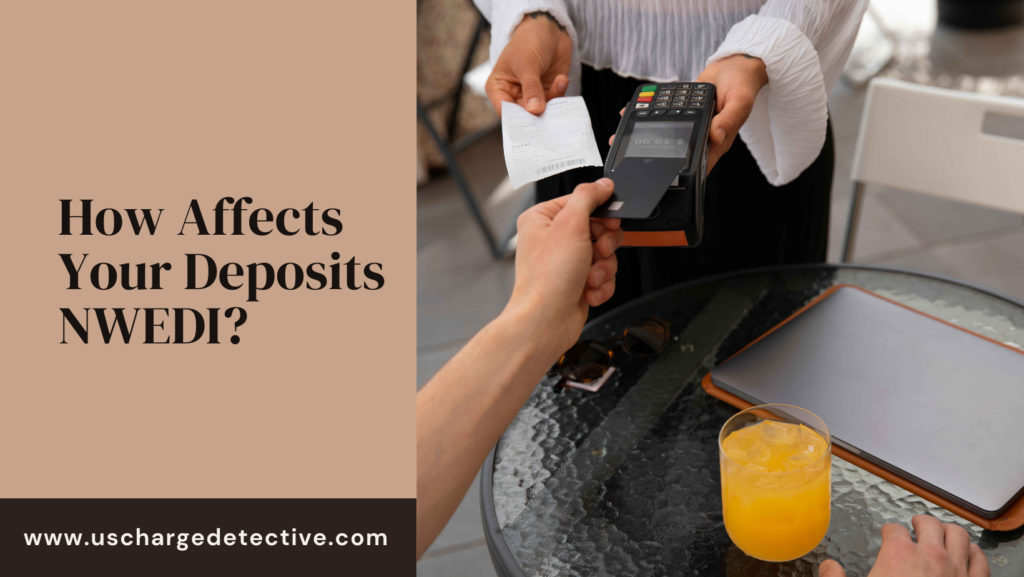On a bank statement, NWEDI indicates that a deposit was made into your account on an off day for a bank, say a weekend or a public holiday. This is used as a code on a bank statement by banks to show a deposit made into an account even during bank closure.
Has a bank statement ever shown an unknown charge? If yes, be not worried; many of us find it challenging to decipher the financial abbreviations. Since bank statements are vital records including the deposit on them. Essential components of money management are these ones.
I will discuss my experience investigating the charge, review this code word and what it implies on a bank statement, and show how it will affect your deposit and a bank statement in this tutorial. Thus, buckle your seat belts and fully understand the fee once and for once.
Understanding NWEDI: The Analysis
Non-Workday Electronic Deposit Item is abbreviated NWEDI. Basically, it’s a communication from your bank alerting you to an electronic deposit made into your account on a day not usual business hours. As banks are closed for business on weekends or public holidays, so too is.
The Importance of NWEDI: It Is More Than Just a Guideline
Though it seems like a small issue, this shortened code is quite important. Differentiating non-working day deposits from regular business hours helps to more readily identify them for processing needs, thereby proving helpful for:
With confidence, straighten the accounts.
Knowing the secret code will enable you to precisely match payments or deposits with wages or transfers even if money arrives one day or two later.
Enhanced Money Tracking
Knowing when deposits start on non-working days helps you to better see your whole cash flow position.
Clearing Confusion
It helps you to get a clear view of account activity by removing any doubt about deposits made outside of standard banking hours.
How Affects Your Deposits NWEDI?
Using an example will help you to understand the effect on your deposit: let’s consider:
Assume you are a freelancer with regular invoice clients and your bank business days fall Monday through Thursday. After your project is completed, forward the invoice to your client and start electronic fund transfers that same day.

But Friday the following day is non-working for your bank. Although it was handled on the same day, your account not show the payment till Monday. Your bank statement will display a NEWDI deposit from your bank, which denotes that electronic funds were made on a non-working day.
Why appears NWEDI on your bank statement?
As said above, this charge code shows on your bank statement when deposit flows in your account on a day other than the bank’s regular working days, say weekends or public holidays.
Banks used to keep the money whenever a deposit entered an account owned by their customers on non-business days. And release those money within business banking hours on the next working day.
A Saturday deposit would not be accessible until Monday then. Thank goodness, technology has changed everything! The cash are easily available since most banks now quickly and electronically handle these deposits.
What effect does NWEDI have on my bank statement?
My bank statements show no discernible change depending on this charge; it’s only a code used by banks to show that deposits were made on non-business days and may be immediately seen in your account balance.

Especially, keep in mind that deposits made on non-working days could show on your bank statement later on since banks usually produce statements on working days; any transactions made outside these times may not be noted until the next statement has been produced.
Reading Your Bank Statement: Techniques
Knowing what NWEDI implies now will help us to explore further how to interpret your bank statement. When reading a statement, you should focus on the following few salient features:
Account Records
At the top of your bank statement will be information about your account number, type, and statement period in clear sight.
Balances of Opening and Closing
Closing balance is what remains at the end of the statement period; opening balance is at its beginning.
Deposits
Deposits are your inflows of all the transactions together with dates, quantities, and sources for every one.
withdrawals
During the statement period, withdrawals represent your outflows together with the date, amount, and source of each payment made.
fees
Charges your bank made against services including ATM fees, overdraft costs monthly maintenance fees, etc. are called fees.
interest
Regarding the interest your savings account generates, that indicates profit during that period. The statement reveals your inflows here.
Final equilibrium
At the end of the period, ending balance shows on a bank statement following withdrawal deduction from your deposit. Just subtract outflow from inflow.
How to Get Your Bank Statement?
Most banks allow you several ways to access your account statement. Here are a few often-used methods:
Online Finance
Online banking sites include Internet banking and WhatsApp Banking let you view and download your bank statements after logging into your account.
Mobile Finance
Your bank statement can be obtained via the mobile banking app; the remainder of the process is the same as described above using online banking.
Written Statements
Some banks still utilize this antiquated approach, which generates paper statements that usually find their delivery right at your address after each statement period. This alternative might cost, though.
Why Should You Go Over Your Bank Statement?
Regular review of your bank statement helps to guarantee that all recorded transactions are accurate; here are a few more reasons:
- to find the scam or any mistake.
- For the development of an expenditure-tracking budget.
- for monitoring your loan.
- For tax reasons.
- To identify any odd charges on your bank statement.
Frequently asked questions are found in FAQs.
Does any bank follow this code?
Based on an ING Wholesale Banking Bulgaria reference of this code in their terms and conditions document, we assume they might employ NWEDI on bank statements.
Are Every Bank Making Use of the Code Regarding Non-Workday Deposits?
Not always; not every bank uses the code to gauge non-workday deposits. While some banks would describe deposits outside business hours using alternative terminology or codes, others may use it.
Are withdrawals as well as deposits possible using Non-Workday Electronic Deposit Item Codes?
Not at all. These rules should be followed exclusively for non-working-day deposits, not withdrawals.
Does my bank apply these codes? How can I find out?
You can find out whether your bank indicates non-workday deposits on bank statements using the code or otherwise:
For specifics on statement codes and terms they employ, visit their website or mobile app; many banks include glossaries or FAQs outlining popular abbreviations used inside their company.
Do Non-Workday Electronic Deposit Item Codes Usually Have Common Errors?
Regretfully, non-workday electronic deposit item codes do not contain any specifically occurring mistakes. Rather, some banks utilize these particular codes to identify electronic deposits made on weekends or holidays on non-working days.
Conclusion
Banks basically utilize it to differentiate between deposits made on business days and non-working days. Your account balance will not be much affected; all deposit amounts will still show on your balance statement.
Since banks usually create statements on working days, these deposits could show more slowly on your statement. Often connected with direct deposits or other electronic fund transfers, these are acceptable and widespread.
